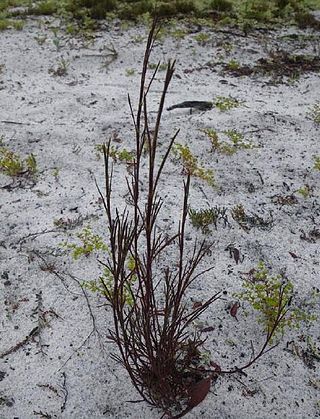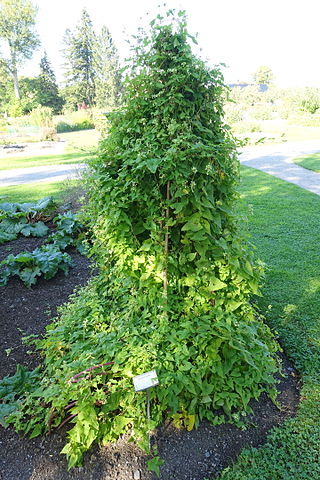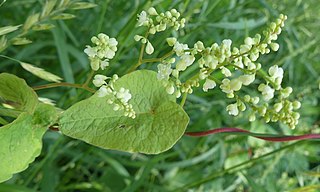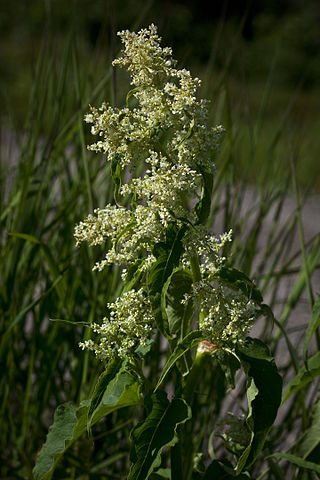
The Polygonaceae are a family of flowering plants known informally as the knotweed family or smartweed—buckwheat family in the United States. The name is based on the genus Polygonum, and was first used by Antoine Laurent de Jussieu in 1789 in his book, Genera Plantarum. The name may refer to the many swollen nodes the stems of some species have, being derived from Greek, poly meaning 'many' and gony meaning 'knee' or 'joint'. Alternatively, it may have a different derivation, meaning 'many seeds'.

Polygonum is a genus of about 130 species of flowering plant in the buckwheat and knotweed family Polygonaceae. Common names include knotweed and knotgrass. In the Middle English glossary of herbs Alphita, it was known as ars-smerte. There have been various opinions about how broadly the genus should be defined. For example, buckwheat has sometimes been included in the genus as Polygonum fagopyrum. Former genera such as Polygonella have been subsumed into Polygonum; other genera have been split off.

Fallopia is a genus of about 12 species of flowering plants in the buckwheat family, often included in a wider treatment of the related genus Polygonum in the past, and previously including Reynoutria. The genus is native to temperate and subtropical regions of the Northern Hemisphere, but species have been introduced elsewhere. The genus includes species forming vines and shrubs.

Muehlenbeckia or maidenhair is a genus of flowering plants in the family Polygonaceae. It is native to the borders of the Pacific, including South and North America, Papua New Guinea and Australasia. It has been introduced elsewhere, including Europe. Species vary in their growth habits, many being vines or shrubs. In some environments, rampant species can become weedy and difficult to eradicate.

Oxyria is a genus of plants in the family Polygonaceae with three accepted species as of March 2019. It has a circumboreal distribution.

Oxygonum is a genus of plants in the family Polygonaceae with about 30 species. It is native to eastern parts of Africa and to the Arabian Peninsula.

Koenigia is a genus of plants in the family Polygonaceae. The genus Aconogonon has been merged into Koenigia.
Knorringia is a genus of plants in the family Polygonaceae. It is native to Central Asia and Siberia.

Atraphaxis is a genus of flowering plants in the family Polygonaceae with about 40 species.

Bistorta is a genus of flowering plants in the family Polygonaceae. As of February 2019 about 40 species are accepted. It has been supported as a separate clade by molecular phylogenetic analysis. Bistorta species are native throughout much of the Northern Hemisphere, as far south as Mexico in North America and Thailand in Asia.

Duma florulenta, commonly known as tangled lignum or often simply lignum, is a plant native to inland Australia. It is associated with wetland habitats, especially those in arid and semiarid regions subject to cycles of intermittent flooding and drying out. The Wiradjuri name for the plant is gweeargal, and the Walmajarri name is Kirinykiriny, or Kurinykuriny.

Polygonum basiramia is a rare species of flowering plant in the knotweed family known by the common names wireweed, hairy wireweed, purple wireweed, and Florida jointweed. It is endemic to Florida in the United States, where it is limited to the central ridges of the peninsula, including the Lake Wales Ridge. It is threatened by the loss and degradation of its habitat. It is a federally listed endangered species of the United States.

Polygonum dentoceras is a rare species of flowering plant in the knotweed family known by the common names sandlace, woody wireweed, and Small's jointweed. It is endemic to Florida in the United States, where it is limited to the central ridges of the peninsula, including the Lake Wales Ridge. It is threatened by the loss and degradation of its habitat. It is a federally listed endangered species of the United States.

Pteroxygonum is a plant genus in the family Polygonaceae. As of March 2019, two species are recognized. Their native range is from Tibet to southeast China.
Polygonum smallianum is a species of flowering plant in the knotweed family known by the common name largeleaf jointweed. It is native to a small area around the border between Alabama and Florida in the United States.
Polygonum delopyrum, the fringed jointweed or hairy jointweed, is a plant species endemic to Florida. It is found in pinelands and sandy pine barrens at elevations less than 50 m, in central and southern parts of the state.

Reynoutria is a genus of flowering plants in the family Polygonaceae. The genus is native to eastern China, Eastern Asia and the Russian Far East, although species have been introduced to Europe and North America. Members of the genus, including R. japonica and its hybrid with R. sachalinensis, are highly invasive plants.

Polygonoideae is a subfamily of plants in the family Polygonaceae. It includes a number of plants that can be highly invasive, such as Japanese knotweed, Reynoutria japonica, and its hybrid with R. sachalinensis, R. × bohemica. Boundaries between the genera placed in the subfamily and their relationships have long been problematic, but a series of molecular phylogenetic studies have clarified some of them, resulting in the division of the subfamily into seven tribes.

Polygonum ciliinode is a species of flowering plant in the family Polygonaceae, native to central and eastern Canada, and the north-central and eastern United States. The specific epithet is also spelt cilinode.

Tanja Magdalena Schuster is a taxonomist from Kaindorf, Austria and the first Pauline Ladiges Plant Systematics Fellow, holding a joint position with the School of Biosciences, University of Melbourne, Victoria, Australia, and the National Herbarium of Victoria, Royal Botanic Gardens Melbourne. Schuster also worked as curator of the Norton-Brown Herbarium at the University of Maryland, College Park.

















